The Annular Eclipse of October 14, 2023
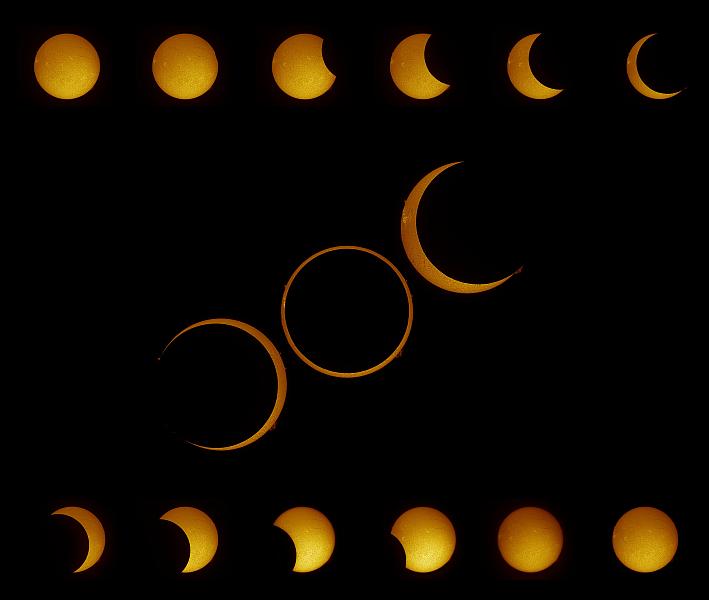
|
| Click on image for a full-size version. |
| An annular eclipse sped over North America on October 14, 2023. This was the second time I traveled to experience an annular eclipse, the last time being in May 2012. Interestingly, both times the centerline of the eclipse (when peak annularity was centered on the Sun's disk) passed over Albuquerque, New Mexico. As journaled back in 2012, we did not view the eclipse from that city. I was hoping we would view from Albuquerque this second time, but this time around we realized that the date of the eclipse coincided with that city's annual balloon festival, which would have likely made accommodations rare and expensive. | |
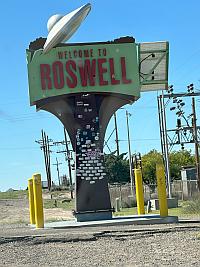 |
Our small eclipse party (my wife, a friend and I) decided to drive to Roswell, New Mexico. This quaint little town, famous for the apparent alien crash back in 1947 (and themed as such), was not quite on the centerline, but close enough. Driving also enabled us to bring all our equipment for viewing and imaging the eclipse. We arrived late in the afternoon of October 12. It was late enough that scouting around for a viewing spot was not feasible. We did spend the evening doing a quick polar alignment of our equatorial mount in hopes of generally good tracking during the event. |
| The following day (October 13), we scouted around for some candidate areas to view the eclipse. Which we also used as a good enough reason to take in some of the sights of the area. We decided on Bottomless Lakes State Park, which was not that far (about a 1/2-hour drive, perhaps?) southwest of downtown Roswell. This is an unexpectedly delightful area to visit and highly recommended to check out if one is in the area. |
 Click on Preview for a larger image |
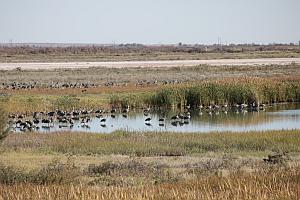 Click on Preview for a larger image |
Our other candidate was the Bitter Lake National Wildlife Refuge. Which our friend warned us could be a haven for bugs given the fact that this is a wildlife refuge and would likely have water. Which turned out to be true on both fronts. In addition, while the wildlife drive area allowed for plenty of opportunities to set up and view the eclipse, the only rest rooms available were in the visitor center, which we were concerned could have been crowded during the eclipse. These factors guided us towards the Bottomless Lakes area. |
| We revisited Bottomless Lakes State Park that evening to take advantage of what we hoped would be dark skies over that park. We were not disappointed. This was taken with a Canon EOS Rebel t6i using a Tokina 11-20mm lens at 11mm and f/2.8. This is a 6-second exposure at ISO 6400. |
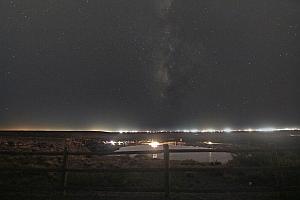 Click on Preview for a larger image |
| We were up and early on Eclipse Day, and after a quick breakfast at our hotel we drove off to claim our spot at Bottomless Lakes. We arrived about an hour and a half before the start of the eclipse, which allowed us plenty of time to set up all our equipment and for me to tune our double-stacked H-alpha telescope. Not unexpectedly, there was a small hiccup in that I had planned to capture the eclipse in both white light and H-alpha and brought the necessary equipment to do so. Unfortunately I forgot our White Light Wedge back at the hotel. I decided that capturing H-alpha data was my primary goal for this eclipse anyway and opted not to rush back to the hotel to grab the wayward item. Which was just as well; this helped simplify my tasks. | |
| The morning was perfectly clear as the eclipse started, though we remained wary of a forecast of partly cloudy skies for the area. I set up my equipment, a Lunt LS60PT with a Lunt LS50Fha double-stack system atop a Takahashi EM-11 mount. The LS50FHa and B1200 blocking filter were actually the same equipment I used for the 2012 annular eclipse; they were now repurposed as double-stacking elements for our LS60PT scope. The imaging camera used was a ZWO ASI174MM. |
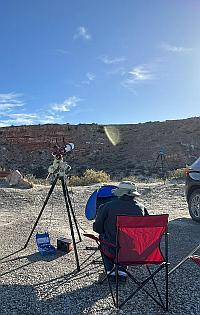 Click on Preview for a larger image |
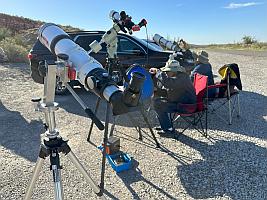 Click on Preview for a larger image |
Once our system was properly setup, focused,
tuned and tracking, I loaned our friend a manual alt-az mount so
he could set up his Vixen 80mm refractor as a second white-light
setup for viewing the eclipse in white light and for sharing
with anyone passing by. Which there were a few. Now you may ask: since our friend had two white light setups, why didn't I use his 80mm Vixen as a white light scope? The answer was that I wasn't sure of the stability of that dual setup with our mount in a side-by-side configuration. Not so much the mount but the tripod the mount was on. During home tests the dual setup shook when focusing either scope; and the secondary scope was pretty light (Borg 67FL with Lunt 2" Wedge). |
The morning was perfectly clear as the eclipse started, though we remained wary of a forecast of partly cloudy skies for the area. |
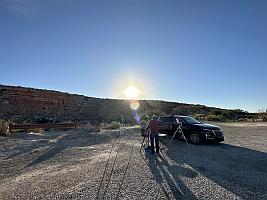 Click on Preview for a larger image |
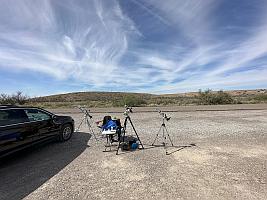 Click on Preview for a larger image |
Fortunately, while clouds did show up as forecast, they turned out to be high, wispy cirrus clouds. And while they dimmed some of my capture data, they did not completely obscure the sun. And more importantly, annularity was not obscured. |
| First Contact was forecast for 9:15AM local time. As this forecast was for Roswell, I started capturing data at 9:14AM in case it was earlier for our location, southeast of the city. The timestamp for when I first spotted a tiny notch on the Sum was 9:16AM. Of course, my laptop's clock could have been off. |
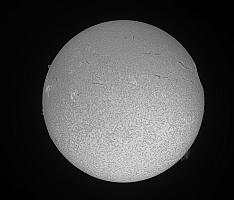 Click on Preview for a larger image |
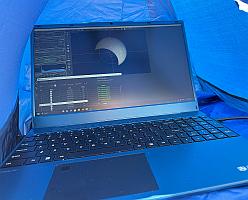 Click on Preview for a larger image |
There were many other eclipse watchers scattered through the park. I didn't have much of a chance to mingle with them, as I was busy tending to our imaging setup. A few came by to chat with us and look through the Vixen 80, which my wife tended. She was also our outreach ambassador, chatting with everyone and anyone who came by. I also shared H-alpha views through my laptop screen for anyone who didn't mind a video shot of the event. |
| Our friend used his DSLR through his 102mm Vixen refractor. He had hoped to use his 80mm Vixen as well with a second camera, but neither he nor I had the extenders necessary for his camera to reach focus. That said, my wife made a valiant effort capturing whatever afocal views she could with her smartphone. One frustration she shared (same as me) is that we're never sure which of the multiple lenses available to use to peek through the eyepiece. That said, she did manage an acceptable shot or two. |
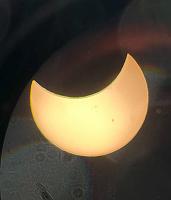 Click on Preview for a larger image |
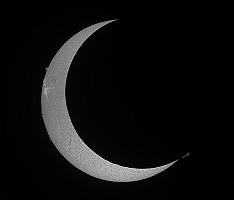 Click on Preview for a larger image |
One phenomenon I was hoping to capture was the disk of the moon eclipsing a prominence before First Contact. Unfortunately there was no prominence large enough to be blocked. At least not at our location. I did have a consolation prize of seeing (and capturing) a large prominence peeking over the edge of the Moon prior to annularity. When I was processing, at first I thought it was an image artifact, but on looking at this and subsequent images I realized that I had indeed captured a prominence peeking over the limb of the Moon! |
| Full annularity was forecast for 9:41AM local time. The timestamp pn my dataset confirms this, as this is the most symmetrical of the images in my sequence. Yes, it's not perfectly centered, but it's way better than my 2012 data set. |
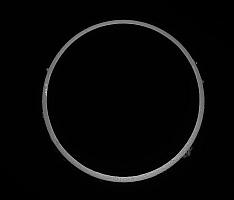 Click on Preview for a larger image |
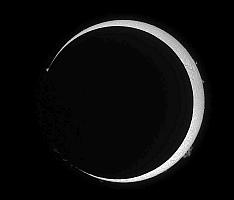 Click on Preview for a larger image |
As the Moon exited the Sun I was able to capture a few faint prominences peeking over its limb (see the lower left of the image - it's best to view the image full size). |
| The clouds that we had been concerned with did not ruin our experience. At worst, they dimmed some of the captures for my sequence. I was able to partially compensate for the dimming by changing camera settings on the fly to allow for the variations in brightness. But I'm happy to report that my captures were not interrupted! In addition, our proximity to rest room facilities was definitely appreciated, as I needed to use them twice. And thanks to my wife, too, who took over for me during my rest room breaks to manually guide our setup. Not unexpectedly, there was enough drift in tracking that needed some manual corrections every few minutes to keep the Sun on the camera. |
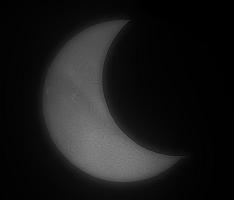 Click on Preview for a larger image |
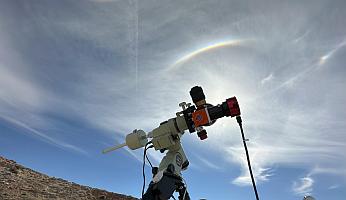 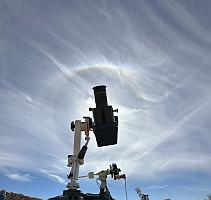 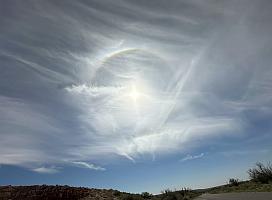 Click on Previews for larger images |
That said, as the eclipse ended and we looked skyward from our cameras, eyepieces or viewscreens, we discovered that the interfering clouds had given us a bonus: an apparition of a solar halo, accompanied by parhelia (or sun dogs), a parhelic circle and possibly a circumscribed arc! As our friend put it, this was like the bonus scenes during or after the credits of Marvel movies (and similar)! |
| Click on the thumbnail for an animation of all 172 images captured during the eclipse. Each image is a stack of 300 frames from videos captured by our H-alpha setup as described earlier. This animation is presented at 15 frames per second. |
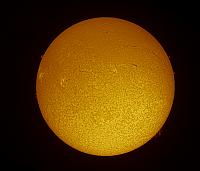 Click thumbnail for animation |
 Click thumbnail for animation |
This is the same animation, slowed to 1 frame per second to give time to enjoy each phase of the eclipse. Note that even frames that were affected by clouds have been included to help keep the animation consistent. |
| This is the mono (grayscale) version of the data at 15 frames per second. This is the data as originally captured; the color versions were artificially colored in Photoshop. |
 Click thumbnail for animation |
 Click thumbnail for animation |
This is the mono (grayscale) version of the data at 1 frame per second. The video frames were captured at 1-minute intervals. |
| Overall, this was a great second annular eclipse experience. One aspect was that we were able to view and image it from beginning to end. In 2012, the sun and Moon had set before the eclipse ended for our location. Newer technology (bigger and faster hard drives for storage, faster capture rate cameras) is always welcome. And images were captured at 1-minute intervals instead of 5 minutes back in 2012. | |
